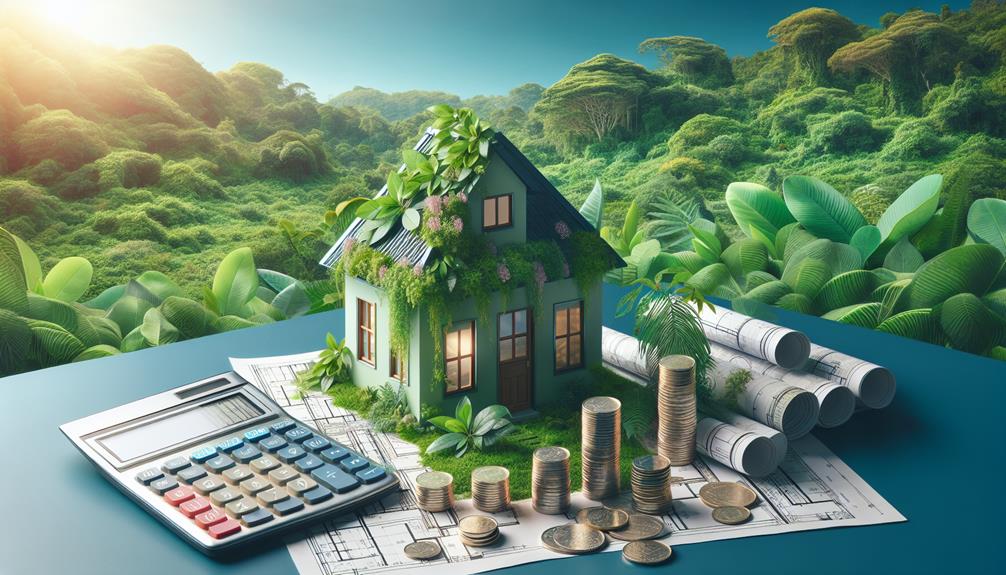Imagine you've found the perfect tiny home design: a sleek, modern 250-square-foot dwelling that seems to tick all your boxes. Now, you're faced with the daunting task of crunching the numbers to see if your dream can align with your budget.
As you start to factor in expenses, you'll notice the costs of materials and craftsmanship vary widely, and the choice between a DIY project or a prefabricated model isn't as straightforward as it seems. You also need to consider the land, the foundation, and not to mention, the unforeseen expenses that inevitably arise.
While the initial figures might be enticing, ranging from the more affordable $30,000 to the deluxe $70,000, there's more to understanding the full financial commitment of joining the tiny home movement.
In the following sections, we'll unpack the nuances of these costs, from the ground up, to help you make an informed decision about whether a tiny home is a smart investment for your future.
Key Takeaways
- The cost of a tiny home can vary greatly depending on factors such as size, finish level, and foundation type.
- Building materials and construction costs, including lumber, insulation, plumbing, electrical, and HVAC systems, should be considered when budgeting for a tiny home.
- Land acquisition and preparation costs, including zoning laws, building codes, and foundation expenses, can also impact the overall cost of a tiny home.
- Ongoing maintenance expenses, such as regular maintenance tasks, servicing of HVAC, electrical, and plumbing systems, and unexpected repairs, should be factored into the budget for a tiny home.
Initial Purchase Options
When starting your tiny home journey, you'll face the initial decision of whether to build a custom home, buy a prefab model, or purchase a pre-owned tiny house.
The cost to build a custom tiny home typically ranges from $50,000 to $140,000. In contrast, prefab tiny house options can vary greatly, with prices as low as $4,000, climbing up to $80,000 for a high-end finish. Factors like size, finish level, and whether you opt for tiny homes on wheels or a foundation play a crucial role in the average cost.
Remember to account for building permits and local regulations, which can affect your tiny house costs. Since financing can be tricky, explore specialized lenders early in your quest to buy a tiny home.
Building Materials Breakdown
Understanding the cost breakdown of building materials for your tiny home is crucial as it directly impacts your overall budget and design choices. The materials cost varies widely, depending on whether you're opting for a tiny house on wheels, which requires a focus on structural integrity and lightweight materials, or a custom-built tiny home with a permanent foundation.
For the average tiny house, construction costs include not just the basics like lumber and insulation, but also plumbing, electrical, and HVAC systems. Finishes, such as a finished exterior, can also affect the price. Don't forget to factor in utilities; innovative options like solar panels or wood stoves could alter your costs.
Land Acquisition and Preparation

Securing the right plot of land is a pivotal step in your tiny home journey, with costs and considerations that can significantly shape your project's budget and timeline.
The cost of land varies by location and is influenced by local real estate markets. You'll need to navigate zoning laws and building codes, which dictate land use and tiny home placement.
Foundation costs depend on the chosen type—permanent or temporary—and the land's soil quality. Don't overlook the preparation expenses: property taxes, connecting to utilities, and installing a septic system if needed.
Adhering to local building regulations ensures compliance and helps avoid costly revisions.
Factor in these variables to accurately plan your land acquisition and preparation budget, setting the stage for your innovative tiny home.
Ongoing Maintenance Expenses
As you settle into tiny home living, remember that regular maintenance is essential to keep your space safe and functional, with expenses that vary depending on your home's size, materials, and systems.
Budget for routine tasks like painting and weatherproofing to protect your tiny house's exterior. Quality of materials influences ongoing maintenance expenses; higher-grade options typically require less upkeep, affecting both depreciation and resale value.
Servicing your HVAC, electrical, and plumbing systems ensures efficiency, particularly if you're using innovative energy sources. Being on a permanent foundation may involve septic tank maintenance, so plan for this.
Set aside funds for unexpected repairs to manage interest rates on emergency loans. Regular maintenance sustains your tiny home's value and livability.
Hidden Costs Unveiled

Peeling back the layers of tiny home ownership reveals hidden costs that can catch you by surprise, from zoning fees to unexpected construction expenses. The final cost of your tiny home isn't just about the price tag of the structure itself; it's crucial to consider additional factors that impact the overall cost.
| Hidden Cost Factor | Potential Expense | Impact on Budget |
|---|---|---|
| Land Cost | Varies widely | Major |
| Zoning Regulations | $1,000s | Significant |
| Utility Connections | $3,000 – $20,000 | Considerable |
| Building Codes | Unpredictable | Variable |
| Property Taxes | Ongoing | Recurring |
Don't overlook installation costs, which include plumbing and electrical work, and prepare for property taxes and utility connections. Stay savvy about zoning regulations and building codes to avoid unexpected expenses that inflate your tiny home's overall cost.
Frequently Asked Questions
What Is a Good Budget for a Tiny House?
You'll want to budget for space optimization and material selection, balancing DIY savings with design complexity. Consider financing options, utility costs, zoning laws, potential resale value, and lifestyle changes for your tiny house.
What Is the Most Expensive Part of a Tiny House?
Breaking the bank for your tiny house often comes from custom finishes and luxury appliances. Investing in high-quality insulation and energy-efficient features like solar panels can also hike up your initial outlay significantly.
Why Did Tiny House Nation Get Cancelled?
Tiny House Nation got cancelled due to waning viewer interest, evolving reality TV trends, and network decisions. Production costs, alternative programming, and cultural shifts also played roles, despite the initial appeal and dynamic cast. Future projects may emerge.
How Much Does It Cost to Build a Tiny House on a Foundation?
Building a tiny house on a foundation isn't just trendy; it's an investment. You'll navigate permitting expenses, material choices, and labor costs, while custom features and design complexity dictate your final price tag.
Conclusion
You're now equipped to navigate the tiny home terrain, where every penny counts and the adage 'look before you leap' is paramount.
Your journey from initial purchase to ongoing maintenance is mapped out, balancing dreams with budgets.
Remember, the true cost of tiny living isn't just in the dollars spent but in the value of simplicity gained.
Forge ahead with confidence, knowing the groundwork laid here steers you toward informed decisions and a home that's worth every square foot.

